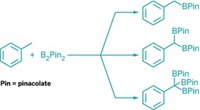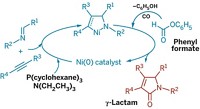Advertisement
Grab your lab coat. Let's get started
Welcome!
Welcome!
Create an account below to get 6 C&EN articles per month, receive newsletters and more - all free.
It seems this is your first time logging in online. Please enter the following information to continue.
As an ACS member you automatically get access to this site. All we need is few more details to create your reading experience.
Not you? Sign in with a different account.
Not you? Sign in with a different account.
ERROR 1
ERROR 1
ERROR 2
ERROR 2
ERROR 2
ERROR 2
ERROR 2
Password and Confirm password must match.
If you have an ACS member number, please enter it here so we can link this account to your membership. (optional)
ERROR 2
ACS values your privacy. By submitting your information, you are gaining access to C&EN and subscribing to our weekly newsletter. We use the information you provide to make your reading experience better, and we will never sell your data to third party members.
Synthesis
Gold Doubles Down To Couple Alkynes
Dual catalyst activation stitches together alkynes in reactions that add new perspectives to gold catalysis
by Stephen K. Ritter
February 9, 2015
| A version of this story appeared in
Volume 93, Issue 6
A. Stephen K. Hashmi’s group at the University of Heidelberg, in Germany, has been exploring homogeneous gold catalysis for a long time. The researchers were recently trying what they assumed would be the insertion of a benzylic C–H bond of a substituted toluene into an iodoalkyne group on an adjacent carbon in the ring, via a gold vinylidene intermediate. But to the group’s surprise, a completely different reaction unfolded. The researchers found the active catalyst contains two organogold fragments that act on different ends of the alkyne bond to dimerize the iodoalkyne in a head-to-tail fashion (shown) to form conjugated enynes (Chem. Eur. J. 2015, DOI: 10.1002/chem.201406594). In related gold vinylidene chemistry, involving conversion of aryl diynes to indene derivatives, Hashmi and coworkers have further discovered that in the presence of water the gold vinylidene intermediate forms a rare gold acyl complex, which sheds CO as part of the catalytic cycle (Angew. Chem. Int. Ed. 2015, DOI: 10.1002/anie.201409859). Although CO has been a key component in heterogeneous (surface) catalysis, the decarbonylation process was previously unknown in homogeneous (solution) gold catalysis, Hashmi says.





Join the conversation
Contact the reporter
Submit a Letter to the Editor for publication
Engage with us on Twitter